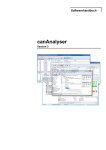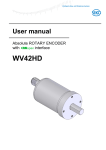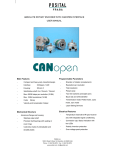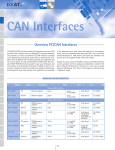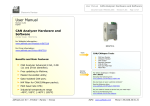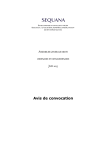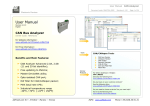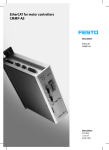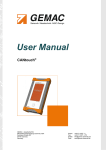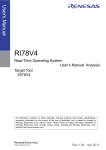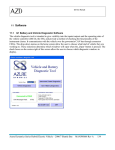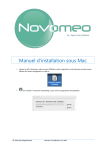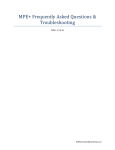Download Manuals
Transcript
CANopen Device Manager Service and Test Tool for CANopen® Devices User Manual Doc. no. 4.12.0157.20000 Rev. 3.3 IXXAT CANopen Device Manager 1 Table of Contents 1. Introduction 2 2. Important User Information 3 3. Installation and First Steps 4-5 4. CANopen Device Manager Functionality 6-7 4.1. Menu, Toolbar, and Status Bar 4.2. Plug-In Configuration 10-11 4.3. Application Options 11-13 4.4. Configuration of the CAN Interface 14-15 4.5. Operating CANopen Device Manager together with CAN Bus Monitors 16-17 5. Network Configuration 8-10 18-19 5.1. Working with the Network List 20-21 5.2. Add a Device to the Network List 22-23 5.3. Emergency Messages 23 6. Device Selection 7. Device Management 25-27 8. SDO Services 28-30 9. PDO Services 31-32 10. Configuration Download and Firmware Update 11. 24 33 10.1. Concise DCF Download 34-35 10.2. Firmware Update 35-36 LSS Master Services 37-38 11.1. Configuration of Local Layer Settings 38-39 12. References 13. Glossary 41-42 14. Support 43 ©2015 IXXAT Automation GmbH. All Rights Reserved. 40 2 1 IXXAT CANopen Device Manager Introduction IXXAT CANopen Device Manager The CANopen Device Manager is a modular tool that provides simplified visual device management and access services for CANopen networks. Typical applications of the CANopen Device Manager include diagnostics and configuration of single devices and topology analysis of networks. It will help service technicians to analyze and solve problems in previously configured systems as well as assist engineers with testing individual CANopen components. The CANopen Device Manager is not intended to replace a dedicated CANopen network configuration tool, however it may be used to complement such a tool or to set up simple networks that include only a few devices and require limited configuration effort. The efficient use of the CANopen Device Manager in application areas as indicated above is supported by the availability of an extensive range of CANopen services as described in the CiA 301 specification by CAN in Automation. The supported functionality includes: Network topology analysis and device identification NMT and error control services, including heartbeat monitoring and node guarding Monitoring of emergency messages Support for SDO services normal, expedited, and block transfer, including support for CRC verification Event triggered, synchronously polled, or remotely requested PDO transmission, single shot SYNC transmission or adjustable communication cycle periods in steps of 1ms. Support of SYNC counter according to CiA301 Support for EDS and XDD device description files as specified in CiA 306 and CiA 311 Object dictionary browser supported SDO access to CANopen devices SDO download or upload of bulk data to and from files Concise DCF download and firmware update as described in CiA 302 Layer setting services master according to CiA 305 The available CANopen services are implemented using plug-in modules, which also allows for customer or CANopen device specific enhancements to the default functionality. Although data logging is not inherently supported by CANopen Device Manager, this functionality can be added by running CANopen Device Manager concurrently with IXXAT bus monitoring tools such as MiniMon (included with the IXXAT VCI driver software) or IXXAT canAnalyser (separate product). For details see the section on Operating CANopen Device Manager together with CAN Bus Monitors. Note that certain services provided by CANopen Device Manager may compromise network stability and may result in undefined network behavior if not used with the required precautions. The CANopen specifications allow only one active NMT master device in a CANopen network. When executing NMT services, CANopen Device Manager temporarily assumes NMT master functionality. Before executing NMT services in an unknown CANopen network verify that no other NMT master device is active. For network or device scan operations CANopen Device Manager uses the default server SDO of a device, which may also be used by another SDO client like a network manager. Please consult the CANopen specifications for further information on these services. The improper use of CANopen Device Manager may cause malfunctioning or destruction of communication network devices and of systems controlled by them. IXXAT Automation GmbH is not liable for consequential damages of communication network devices and of the systems controlled by them. ©2015 IXXAT Automation GmbH. All Rights Reserved. IXXAT CANopen Device Manager 2 3 Important User Information Liability Every care has been taken in the preparation of this manual. Please inform IXXAT Automation GmbH of any inaccuracies or omissions. The data and illustrations found in this document are not binding. We, IXXAT Automation GmbH, reserve the right to modify our products in line with our policy of continuous product development. The information in this document is subject to change without notice and should not be considered as a commitment by IXXAT Automation GmbH. IXXAT Automation GmbH assumes no responsibility for any errors that may appear in this document. There are many applications of this product. Those responsible for the use of this device must ensure that all the necessary steps have been taken to verify that the applications meets all performance and safety requirements including any applicable laws, regulations, codes, and standards IXXAT Automation GmbH will under no circumstances assume liability or responsibility for any problems that may arise as a result from the use of undocumented features, timing, or functional side effects found outside the documented scope of this product. The effects caused by any direct or indirect use of such aspects of the product are undefined, and may include e.g. compatibility issues and stability issues. The examples and illustrations in this document are included solely for illustrative purposes. Because of the many variables and requirements associated with any particular implementation, IXXAT Automation GmbH cannot assume responsibility for actual use based on these examples and illustrations. Intellectual Property Rights IXXAT Automation GmbH has intellectual property rights relating to technology embodied in the product described in this document. These intellectual property rights may include patents and pending patent applications in the US and other countries. Trademark Acknowledgements Anybus® is a registered trademark of HMS Industrial Networks AB. IXXAT® is a registered trademark of HMS Industrial Networks AB. CiA® and CANopen® are registered Community Trademarks of CAN in Automation e.V. Microsoft® and Windows® are registered trademarks of Microsoft Corporation. All other trademarks are the property of their respective holders. ©2015 IXXAT Automation GmbH. All Rights Reserved. 4 3 IXXAT CANopen Device Manager Installation and First Steps System Requirements To operate CANopen Device Manager, the following system requirements must be met: x86 compatible processor, 1 GHz or better Microsoft Windows Vista, Windows 7, Windows 8, Windows 8.1 At least 256 MB RAM Installed .NET Framework 2.0 Installed IXXAT VCI driver, version 3.2 or higher Before installing CANopen Device Manager, the IXXAT VCI driver must be installed. To install the CAN hardware, please consult the corresponding hardware installation manual. For installation of the required IXXAT VCI driver, please consult the VCI installation manual. Installation To install CANopen Device Manager, insert the program CD into the CD drive of your computer and start the installation program by running the file CANopenDeviceManager3_3_X_XXXX_Setup.exe. Follow the instructions of the installation program. Start-Up CANopen Device Manager is started by clicking on the program icon created on the desktop or via the Windows Start menu. Software Protection As of version 3.0 of CANopen Device Manager a software protection scheme has been introduced which uses as USB hardware dongle to license the software. The software protection uses the CodeMeter stick by Wibu Systems AG. For more information on additional features available to the user see the CodeMeter portal at http://www.codemeter.com/. Installation The installation of the CodeMeter user runtime is integrated into the CANopen Device Manager installation. If you want to de-install the CANopen Device Manager you have to de-install the CodeMeter user runtime separately. The CodeMeter Runtime Kit can be uninstalled easily on Microsoft Windows operating systems. Open the control panel and choose Add/Remove Programs, select CodeMeter Runtime Kit and choose Remove. All driver files and the entries in the registry will be removed from the computer automatically. Operation During operation of the CANopen Device Manager the CodeMeter stick with the appropriate license has to be plugged into the USB port. Otherwise a dialog with a corresponding error message will be displayed and the CANopen Device Manager application will be terminated. ©2015 IXXAT Automation GmbH. All Rights Reserved. IXXAT CANopen Device Manager Virtual Disk Please note that the removable disk that is created by the CodeMeter stick must not be used for storing user data! The displayed 2 MByte memory is only a virtual disk space, which is required by your system to correctly identify the CodeMeter stick. ©2015 IXXAT Automation GmbH. All Rights Reserved. 5 6 4 IXXAT CANopen Device Manager CANopen Device Manager Functionality Overview The IXXAT CANopen Device Manager is a single window application that implements the most frequently used CANopen communication mechanisms. The standard functionality of CANopen Device Manager is complemented by plug-in modules that provide additional support for dedicated analysis, configuration, or service tasks. User interface components associated with these plug-in modules are organized in individual tab pages inside the main application window of the CANopen Device Manager. Project Files CANopen Device Manager supports backing up of network configuration data in project files. This includes parameters related to the network itself such as bit rate and frame format, but also parameters related to devices attached to the network and their current values. Using project files accelerates the process of restarting work with specific networks since parameters like path information of corresponding device description files do not have to be reassigned. CANopen Device Manager project files use a schema based XML data format. This enables other applications to easily access the information contained in the project files and process project data. User Interface The user interface of CANopen Device Manager is divided into three primary areas. The menu system with main menu and the standard tool bar, the primary work space with a tab control allowing the selection of active plug-in modules, and the status bar providing status and progress information at the bottom of the main application window. ©2015 IXXAT Automation GmbH. All Rights Reserved. IXXAT CANopen Device Manager Menu system and toolbar Workspace Status bar ©2015 IXXAT Automation GmbH. All Rights Reserved. 7 8 IXXAT CANopen Device Manager 4.1 Menu, Toolbar, and Status Bar Menu Description File (keyboard accelerator: Alt+F) Icon Command Keyboard shortcut Keyboard accelerator Description New Ctrl+N Alt+F, N Creates a new project file Open... Ctrl+O Alt+F, O Opens an existing project file Save Ctrl+S Alt+F, S Saves changes to the current project file Save As... Alt+F, A Save changes to the current project file under the specified file name Recent Projects Alt+F, j Contains the last recently used projects Exit Alt+F, x Closes the CANopen Device Manager application Keyboard accelerator Description Tools (keyboard accelerator: Alt+T) Icon Command Keyboard shortcut Clear Emergency Buffer Clears the internal emergency message buffer of CANopen Device Manager Plug-Ins... Alt+F, P Opens the plug-in configuration dialog Options... Alt+F, O Opens the application options dialog ©2015 IXXAT Automation GmbH. All Rights Reserved. IXXAT CANopen Device Manager 9 Network (keyboard accelerator: Alt+N) Icon Command Keyboard shortcut Keyboard accelerator Description Configuration... Opens an options dialog specific to the CAN access parameters. Used to select the CAN hardware channel to connect to the network and to configure the corresponding bit rate settings Search Bit Rate Attempts to identify the bit rate currently used for communication within the CAN network Connect Connects to the network using the specified hardware channel and bit timing parameters Disconnect Disconnects from the network Help (keyboard accelerator: Alt+H) The Help menu gives access to online documentation. Icon Command Keyboard shortcut Keyboard accelerator Description Contents Alt+H, C Displays this help file About... Alt+H, A Displays the About CANopen Device Manager window Toolbar The tool bar provides fast access to frequently used commands of the main menu, like New, Open, and Save. Additionally a link to this help file is available. ©2015 IXXAT Automation GmbH. All Rights Reserved. 10 IXXAT CANopen Device Manager Status Bar The status bar provides up to date information on the status and progress of operations currently performed by the CANopen Device Manager. The status bar is sub-divided into three sections. The left section indicates the current state of the CAN connection. It contains information on the current bit rate, the frame format and the activity of the connection. The middle section displays the kind of process currently being in execution. The right section contains a progress bar indicating the progress of the currently executed process. 4.2 Plug-In Configuration CANopen Device Manager supports a plug-in mechanism, allowing for a customization of the available functionality. Each plug-in module is assigned to one tab page within the tab control of the main window. With the exception of the network configuration page, all tab pages and their corresponding plug-in modules can be activated and deactivated at run-time. The plug-in mechanism allows the user to configure an optimized workspace only containing the required functionality and thus reducing user interface overhead. Included with the standard installation are device management, SDO services, PDO services, configuration and firmware download, and LSS master plug-in modules. The Plug-In Configuration dialog is opened from the Plug-Ins menu item under the Tools pull-down menu. ©2015 IXXAT Automation GmbH. All Rights Reserved. IXXAT CANopen Device Manager 11 Description of column headers in the Plug-In Configuration dialog Header Description Active Indicates if a plug-in is activated. File The file that contains the plug-in code. Plug-In The name of the plug-in. Version The version of the assembly the plug-in is contained in. Description A short description of the functionality of the plug-in. The dialog lists all correctly identified plug-in modules. If a list item is checked the corresponding plug-in module is activated and visible in the tab control of the application main window. Un-checking the list item removes the plug-in from the list of active modules. Additionally the list contains additional information like file name and location, version number, and a functionality description. CANopen Device Manager is only aware of plug-in modules that are either located in the plug-in sub directory in the application directory or that have been loaded at least once before. The Open... button allows the selection of any file having the extension .dll and implementing the required plug-in interface. If a valid plug-in is identified in the selected file it is added to the list in the plug-in configuration dialog. If the selected file does not contain a valid plug-in module or is not compatible with the installed version of CANopen Device Manager a corresponding error message is displayed. 4.3 Application Options The Options dialog is used to set application specific parameters. These include timeout parameters for certain CANopen services, default locations for device description and project files, as well as specific preferences for the CANopen store, restore parameter services. The corresponding dialog window is opened from the Options menu item under the Tools pull-down menu. ©2015 IXXAT Automation GmbH. All Rights Reserved. 12 IXXAT CANopen Device Manager The first tab of the Options dialog window permits configuration of timeout parameters for SDO and LSS services. These parameters define the time the CANopen Device Manager application waits for a service request response from a SDO server or a LSS slave to a service request before it assumes that the services have failed. The value of these two parameters directly affects the operation of the CANopen Device Manager . If the timeout parameters are set too low a SDO transfer or a LSS command may not be executed successfully as the initiator of the service request will abort the operation before the SDO server or the LSS slave answers. A high value of the corresponding timeout parameters will result in long wait times if the communication partner is not available or cannot respond. The lower group box on the General tab page relates to the emergency message list on the Network Configuration tab page of the main window. The buffer size control sets the number of messages buffered in the list which is implemented as a first in-first out buffer. The last group on the General tab contains the "Load last opened Project" option. As the name indicates selecting this option causes CANopen Device Manager to load the most recently used project on start up. The Show Splash Screen option can be used to deactivate the splash screen shown at start up. The second tab page allows the configuration of the default path for the device description file repository and the default path for project files. The default path names depend on the installation of the CANopen Device Manager and are typically C:\Program Files\IXXAT\CANopen Device Manager\EDS for the device description file repository and C:\Program Files\IXXAT\CANopen Device Manager\Projects for project files. ©2015 IXXAT Automation GmbH. All Rights Reserved. IXXAT CANopen Device Manager 13 The third tab page defines default operations for the store, restore parameters mechanism that is an optional functionality of CANopen. The CANopen application layer and communication profile defines different groups of configuration parameters that may be selectively stored or restored. By setting the values of the combo boxes the user can select the group of parameters that will be stored or restored if the corresponding button on the Download tab page is pressed. The save all parameters, save communication parameters, save application parameters, and save manufacturer defined parameters (sub-index 04h) are supported, along with the corresponding restore operations. For additional information see CiA 301. ©2015 IXXAT Automation GmbH. All Rights Reserved. 14 IXXAT CANopen Device Manager 4.4 Configuration of the CAN Interface The connection to the physical CAN network requires the configuration of the interface card that is used for network access. Be careful to select the correct bit rate to avoid compromising network communication. The CAN configuration dialog is opened from the Configuration... menu item under the Network pull-down menu. This dialog allows the selection of both the CAN channel used to connect to the network and the corresponding bit rate. The tree view used to select the CAN controller presents all interface cards that are recognized by the IXXAT VCI driver running on the local system. The particular interface is identified by a hardware number that may be found on the interface. Each interface card supports one or more CAN controllers. Clicking on such a controller selects the corresponding CAN channel and the color of the icon representing the particular controller turns from grey to black. Depending on the hardware interface this operation may take a few seconds as the controller has to be initialized by VCI. If the controller icon turns to red, the initialization has failed and the controller is not available for use by CANopen Device Manager. The icon color turns blue if the controller is locked by another application that uses the controller in parallel. In this case the controller can be used in parasite mode but may not be configured by CANopen Device Manager. Unselected CAN controller Selected CAN controller CAN controller locked by another application CAN controller initialization failure The bit rate at which the CAN controller will operate is set from a combo box control. If the controller is locked by another application a blue icon appears for the selected controller and the combo box will be disabled. If supported by the CAN interface low-speed CAN operation according to ISO 11898-3 can be activated for the selected CAN channel using the Enable Low-speed CAN checkbox. ©2015 IXXAT Automation GmbH. All Rights Reserved. IXXAT CANopen Device Manager 15 After finishing the CAN controller configuration the connection to the network can be established from the Connect menu item under the Network pull-down menu. Successful connection is indicated in the status bar by an Online text label. The connection to the CAN network is deactivated with the Disconnect menu item. The CAN Configuration dialog will be automatically opened by CAN access operations if the configuration has not been previously performed or the CANopen Device Manager is offline. If the configuration is confirmed from within the CAN Configuration dialog, CANopen Device Manager will establish the network connection and execute the requested operation, otherwise the operation will be aborted. Bit Rate Detection If the interface is configured to operate in ISO 11898-2 high-speed CAN mode, CANopen Device Manager supports automatic detection of the bit rate utilized in the CAN network. Activating this mechanism from the Search Bit Rate menu item under the Network pull-down menu will stop all currently active communication. If the bit rate detection is successful, the controller is automatically set to the identified bit rate. The bit rate detection may not succeed if there is no or little traffic in the network. ©2015 IXXAT Automation GmbH. All Rights Reserved. 16 IXXAT CANopen Device Manager 4.5 Operating CANopen Device Manager together with CAN Bus Monitors CANopen Device Manager may be operated concurrently with CAN bus monitors such as IXXAT MiniMon or IXXAT canAnalyzer that use VCI as software interface to the CAN network. If multiple interfaces share a common CAN interface one of the applications will acquire exclusive control of the CAN interface settings. Typically a bus monitor application will be started before and the CAN interface will be configured from the bus monitor. For an example based on the IXXAT canAnalyser see the figure below. Once this configuration has been performed CANopen Device Manager may be started. In the CAN Configuration dialog those CAN controllers that are controlled by the bus monitoring application are highlighted in blue when selected and the bit rate configuration control is disabled. See the example below. ©2015 IXXAT Automation GmbH. All Rights Reserved. IXXAT CANopen Device Manager ©2015 IXXAT Automation GmbH. All Rights Reserved. 17 18 5 IXXAT CANopen Device Manager Network Configuration Overview The IXXAT CANopen Device Manager is implemented using an internal data storage to maintain device information that is either required for, or facilitates the access of CANopen devices. Before using CANopen Device Manager to access devices in a network, individual devices have to be initialized in the data storage representing the currently active network configuration. CANopen Device Manager offers two alternative approaches to add devices to a configuration. A scan of the connected network attempts to identify CANopen devices by uploading selected device data into the internal data storage of the CANopen Device Manager. Optionally a device may be added explicitly by specifying the node-ID with possible other data of the device. Selected information on all currently available devices is summarized in the Network List on the Network Configuration tab page. ©2015 IXXAT Automation GmbH. All Rights Reserved. IXXAT CANopen Device Manager 19 Description of column headers in the network list view Header Description Node-ID Network-wide unique identifier for each CANopen device. The node-ID is used as sorting criteria by CANopen Device Manager. Name Descriptive device name provided by the user. May contain information on specific device functionality in the context of the currently active network configuration. Device Profile Code indicating the device profile number implemented by the device. For information on available CANopen device profiles consult http://www.can-cia.org/. Device Name Manufacturer device name as uploaded from object 1008h from the object dictionary of the device. Only indicated if the device has been added to the list by means of a network scan or device data was explicitly scanned at least once. Vendor Name Uploaded from object 1018h, sub-index 01h from the object dictionary of the particular device during a network scan. The value returned by the device is matched against a reference list that is available from CAN in Automation. See http://www.can-cia.org/ for further details. Device Description File CiA 306 or CiA 311 compliant device description file that has been assigned to the device. Device description files contain a detailed description of the object dictionary of a CANopen device and are typically made available by the device manufacturer. This information is used by the SDO services plug-in module to assemble data for an object dictionary browser which facilitates access to individual device parameters. NMT State Current NMT state returned by the CANopen device provided that NMT error control has been activated in the Device Management tab page. Depending on user preferences, columns may be reordered by clicking on a specific column and dragging it to the required position. Note that the column order is not serialized in the CANopen Device Manager project files. ©2015 IXXAT Automation GmbH. All Rights Reserved. 20 IXXAT CANopen Device Manager 5.1 Working with the Network List To scan for CANopen devices in a network, click the Scan Network button. This will display a dialog box which enables the user to specify the range of node-IDs that shall be scanned for actively connected CANopen devices. The scan will attempt to detect connected CANopen devices by uploading a predefined set of object dictionary entries from each possible device within the specified node-ID range, beginning with the mandatory object 1000h Device type (see CiA 301 for a description of the CANopen device type). Note that the scan will only commence provided that either a CAN network interface has been configured prior to the scan operation or is in parasite mode. If not, the CAN configuration dialog is opened and the user is prompted to configure an adequate CAN channel. The user may also specify if the scan operation shall include all node-IDs in the specified range, or only devices that have not yet been added to the data storage representing the current CANopen network configuration (default). Depending on the specified scan range, the scan process may take several seconds. During the scan process, CANopen Device Manager will not only attempt to detect connected CANopen devices, but also upload device parameters like identification objects, information related to supported NMT error control mechanisms and configured SDO and PDO communication objects. For a complete list of scanned object dictionary entries, see the table below. ©2015 IXXAT Automation GmbH. All Rights Reserved. IXXAT CANopen Device Manager 21 Objects uploaded from the device during a device scan Object Index Description 1000h Device type (scan is aborted for this device if the upload request is terminated with an SDO abort service). 1008h Manufacturer device name. 1009h Manufacturer hardware version. 100Ah Manufacturer software version. 100Ch Guard time (if not available, node guarding of this device is not supported). 100Dh Life time factor. 1014h COB-ID emergency object. 1017h Producer heartbeat time (if not available, heartbeat monitoring of this device is not available). 1018h Identity object. 1201h - 127Fh SDO server parameter. 1400h - 15FFh RPDO communication parameter. 1600h - 17FFh RPDO mapping parameter (only scanned, if the corresponding RPDO communication parameters exist. The upload process covers only as many objects as indicated in sub-index 00h. Currently at most eight mapping entries are supported. MPDOs are not supported in this release). 1800h - 19FFh TPDO communication parameter. 1A00h - 1BFFh TPDO mapping parameter. Only scanned, if the corresponding TPDO communication parameters exist. The upload process covers only as many objects as indicated in sub-index 00h. Currently at most eight mapping entries are supported. MPDOs are not supported in this release. 1F51h Program control (if not available, program firmware update is not supported). 1F52h Verify program (only scanned if 1F51h exists). ©2015 IXXAT Automation GmbH. All Rights Reserved. 22 IXXAT CANopen Device Manager 5.2 Add a Device to the Network List To explicitly add a device to the network list, use the Add Device button. This will open the Device Properties dialog enabling the user to specify the following properties of the new device. Description of properties that can be customized in the Device Properties dialog Attribute Description Name Descriptive name for the device to be inserted into the network. Node-ID A unique identification number that is used by CANopen to distinguish between different devices. The node-ID has to be selected to equal the node-ID settings of the corresponding device in the network. EDS/XDD File Path to a CiA 306 or CiA 311 compliant device description file. Description Optional description of the device. May contain information of the device functionality within the CANopen network. The Scan Device Parameters check box may be used to request an explicit upload of parameters from the specified device. Some of these parameters are required to execute specific services available with CANopen Device Manager. On confirmation the specified device will be added to the internal data storage of CANopen Device Manager. If a device description file has been specified in the dialog, this operation may require several seconds to complete as the EDS or the XDD file must be parsed and the information contained in the device description file has to be entered into the CANopen Device Manager internal data storage. ©2015 IXXAT Automation GmbH. All Rights Reserved. IXXAT CANopen Device Manager 23 Removing a Device from a Configuration To remove a previously added device from the current network configuration, use the Delete Device Button. Before removing the device from the network list, CANopen Device Manager will request the user to confirm the operation. Modifying Device Properties To modify previously configured parameters of a device in the current configuration, use the Device Properties dialog. The dialog is opened either by double-clicking the device in the network list or by a right-click on the device and selecting Properties... in the pop-up menu. 5.3 Emergency Messages Emergency messages received from CANopen devices added to the current network list are displayed in a dedicated trace window on the Network Configuration tab page of CANopen Device Manager. Selecting the Clear Emergency Buffer menu item under the Tools pull-down menu clears all emergency messages currently buffered by CANopen Device Manager. The list may also be cleared by means of the context menu of the trace window. The size of the internal emergency message buffer is configured from the Options dialog. ©2015 IXXAT Automation GmbH. All Rights Reserved. 24 6 IXXAT CANopen Device Manager Device Selection The device selection component is available all the tab pages of CANopen Device Manager that require explicit selection of the device that shall be addressed by the requested operations. It lists the node-ID of all devices that have been added to the CANopen Device Manager network list by either explicitly scanning the network for devices or manually adding devices in the Network Configuration tab page. In addition to the device selection, the user interface component also permits re-scanning the specified node-ID. This operation updates the internal data storage of the CANopen Device Manager with information retrieved directly from the object dictionary of the selected device by means of SDO upload services. ©2015 IXXAT Automation GmbH. All Rights Reserved. IXXAT CANopen Device Manager 7 25 Device Management Overview CANopen network management is device orientated and follows a master slave structure. Each slave device is controlled executing NMT node control services. CANopen Device Manager supports node control by providing direct access to the five available services Start Remote Node, Stop Remote Node, Enter Preoperational, Reset Node, and Reset Communication. In addition to node control CANopen Device Manager supports the error control services Node Guarding and Heartbeat. For further information on the protocols specified consult CiA 301. ©2015 IXXAT Automation GmbH. All Rights Reserved. 26 IXXAT CANopen Device Manager NMT Node Control CANopen Device Manager provides access to node control services by means of five buttons in the Network Management group box. Clicking any of these button triggers the transmission of the corresponding CAN frame, with the node-ID byte in the CAN frame set to the node-ID of the device currently selected in the Device Selection group box. Activate the All Devices check box if the NMT command shall be transmitted to all CANopen slaves as broadcast. Note that using NMT node control commands in broadcast mode will affect all devices connected to the network and not only those that have been added to the current CANopen Device Manager configuration. NMT Error Control CANopen Device Manager supports device monitoring by means of either Node Guarding or Heartbeat. Control of the corresponding services is available in the Device Monitoring function group on the Device Management tab page. When uploading device parameters, either through a scan during the network configuration process, or explicitly requested with the Rescan Device button, CANopen Device Manager evaluates which NMT error control services are supported by the individual devices. Depending on the available functionality, the corresponding radio buttons on the user interface of CANopen Device Manager are disabled or enabled. To start NMT error control select one of the available radio buttons. Note that for Heartbeat monitoring to work a corresponding Heartbeat producer time has to be configured in object dictionary entry 1017h on the selected device. Use the SDO Services plug-in to perform this operation. The NMT error control status is indicated in the Device State group box. The available information includes if monitoring is activated or not and, if applicable, the current NMT state of the device. The internal monitoring mechanism of CANopen Device Manager will attempt to re-synchronize with the toggle bit in the node guarding protocol after an error has occurred. If devices re-enter the expected NMT state after the occurrence of the error control event CANopen Device Manager will continue monitoring. Timestamp The Time Stamp group box supports transmission of single time stamp messages. The message transmitted conforms to the TIME_OF_DAY format as specified CiA 301. As the time stamp is based on the date and time properties of the host system on which CANopen Device Manager is executed, the accuracy of the CANopen time stamp message is limited by the precision of the system time of this particular system. Device Information Information on the currently selected device is available in the lower part of the Device Management tab page. Indicated are manufacturer device name, corresponding to the string object at index 1008h in the devices' object dictionary, the hardware version as contained in object 1009h, the software version corresponding to object 100Ah, and the vendor name. The vendor name is retrieved from the identity object at 1018h, which is displayed as a set of hexadecimal numbers and matched against a reference list available from CAN in Automation. In addition the implemented CANopen device profile is indicated. If the corresponding device profile specification is unknown to the installed version of CANopen Device Manager, only the device profile code is indicated. ©2015 IXXAT Automation GmbH. All Rights Reserved. IXXAT CANopen Device Manager Explanation of parameters listed in the device information panel Information Description Device Name The name of the device that is contained in the object 1008h. Hardware Version The hardware version string that is contained in the object 1009h. Software Version The software version string that is contained in the object 100Ah. Vendor-ID The vendor-ID that is contained in the object 1018h sub-index 01h. Product Code The product code that is contained in the object 1018h sub-index 02h. Revision Number The revision number that is contained in the object 1018h sub-index 03h. Serial Number The serial number that is contained in the object 1018h sub-index 04h. Vendor Name The name of the vendor that corresponds to the vendor-ID. Device Profile The device profile number and a textual description of the profile. ©2015 IXXAT Automation GmbH. All Rights Reserved. 27 28 8 IXXAT CANopen Device Manager SDO Services Overview Service Data Objects (SDO) are used to access object dictionary entries on a remote CANopen device. The main purpose of SDOs are device configuration, they can however be used for the exchange of process data as well. Note that SDO services require a confirmed protocol, resulting in a potentially significant protocol overhead for the data transfer. CANopen Device Manager provides full support for all specified SDO services, including expedited, normal, and block transfer. By default either normal (segmented) or expedited transfer types will be used depending on the size of the transferred data. To explicitly activate SDO block transfer select the SDO Block Transfer checkbox. ©2015 IXXAT Automation GmbH. All Rights Reserved. IXXAT CANopen Device Manager 29 To simplify the access of the object dictionary on a remote device, CANopen Device Manager supports a tree view based object dictionary browser. The browser uses data extracted from a device description file assigned to the device during network configuration. See the section on Network Configuration for corresponding instructions. If no device description file is assigned to the selected device, CANopen Device Manager displays a tree that contains only objects that are mandatory according to CiA 301 and have to be implemented by all devices. The corresponding tree nodes are displayed in grey to indicate that no device description file has been loaded. Object Selection CANopen Device Manager allows the specification of the object that will be accessed directly in the tree structure displayed in the object dictionary browser. Alternatively index, sub-index, and length of the object can be directly entered into the corresponding text boxes. The specification of the length is only required for SDO download operations, on upload operations the corresponding text field contains the length of the returned object data. If for integral data types the number of bytes specified in the Length field exceeds the amount of data entered into the Data text field on the user interface the unspecified data bytes are padded with either FFh or 00h, depending on the specified data type. SDO Transmission To execute a SDO service first select the SDO channel to be used for the SDO communication. All configured SDO channels are listed on the SDO Services plug-in indicating the SDO number, as well as the CAN identifiers for transmit and receive frames. Entries displayed in grey represent SDO channels that are not configured and thereby can not be used for a transfer. Explanation of columns in the SDO channels list Header Description SDO Contains the number of the SDO server in the device. RX CAN-ID Contains the CAN-ID that is used for client to server communication. TX CAN-ID Contains the CAN-ID that is used for server to client communication. The SDO transmission is triggered using either the Read or the Write button. The data returned by the device or to be written to the device will be displayed in or retrieved from the Data field of the plug-in module. To support larger amounts of data than the text field can display, CANopen Device Manager provides two buttons that trigger SDO transfers using a file as either data source or target. In this case the data will not be displayed in the text field. The Abort Transfer button is activated as long as a transfer is in progress. It supports the possibility to terminate a running transfer with a SDO abort message. For more information on the SDO abort protocol, consult CiA 301. ©2015 IXXAT Automation GmbH. All Rights Reserved. 30 IXXAT CANopen Device Manager Data Representation If the data is not written to or read from a stream it is displayed in the Data text field. The type of representation can be selected with a combo box. CANopen Device Manager will try to convert the representation on change of the representation format. However some combinations of formats can not be converted to each other. In this case the data field is empty. The data entered it not lost until a new value is entered. If the format is changed back the data reappears. On entering data CANopen Device Manager applies some rules to the input. For example it does not accept characters that have no meaning for the selected format. Also spacing is automatically applied to the formats hexadecimal and binary. If the size of the text field is not sufficient to display the entire data received on upload from a device, a button appears in the text field that allows the user to open a data display dialog in which the data will be listed in both hexadecimal and ASCII representations. ©2015 IXXAT Automation GmbH. All Rights Reserved. IXXAT CANopen Device Manager 9 PDO Services Overview The PDO services plug-in module supports both synchronous and asynchronous transmission of non-multiplexed process data objects. Processing of multiplexed PDOs according to CiA 301 is not supported by this version of CANopen Device Manager. For synchronous PDO protocols CANopen Device Manager supports SYNC object generation with a user configurable cycle period in steps of 1ms. ©2015 IXXAT Automation GmbH. All Rights Reserved. 31 32 IXXAT CANopen Device Manager SYNC Object CANopen Device Manager supports explicit or automatic transmission of CANopen SYNC objects. If the Cycle Period is set to zero, pushing the transmit button will cause one single SYNC message to be transmitted. For any other value the transmit button will start cyclic SYNC transmission with the specified cycle period. The button label then automatically changes to Stop, enabling the user to interrupt the SYNC object generation. CANopen Device Manager does only accept values that are a multiple of 1000. All other values will be rounded to the next multiple of 1000. Checking the Use Counter box enables the SYNC counter. Overflow Value defines at which value the SYNC counter will recycle and restart with a value of 1. Counter Value displays the value that will be transmitted with the next SYNC message. This information is only available if the SYNC message is triggered manually. Also only in manual mode is a Reset Counter button available, which allows to reset the value of the counter back to 1. If cyclic transmission is used the counter always starts with a value of one, independently from the value that was displayed before the transmission was started. It is not possible to explicitly set the counter value PDO Services The Process Data Objects box lists all active transmit and receive PDOs of the selected CANopen device. PDOs displayed in grey are currently not configured and can not be accessed via the PDO service. The presented information includes CAN identifier, if a remote transmission request is allowed on this PDO, the PDO transmission type, inhibit time, event timer, SYNC counter, its length, and a list of application objects mapped into the PDO. CAN identifier, PDO transmission type and mapped object are represented in hexadecimal format, inhibit time, event timer, SYNC counter and PDO length as a decimal number. For information on the PDO transmission type, consult CiA 301. Process data objects may be requested, read or written. Depending on the type of the PDO some operations may not be available. Transmit PDOs may be requested or read. Receive PDOs can only be written. Requesting a PDO causes a RTR frame for the specific PDO to be transmitted. The returned data will be directly displayed in the data field if the device responds. A Read command only retrieves the current data available for this particular PDO from an internal data buffer and displays them in the data field. This operation may return invalid information especially if CANopen Device Manager has not received the corresponding PDO from the device yet. The Write command transmits the corresponding PDO with the data specified in the data field. Data is always represented in hexadecimal format. CANopen Device Manager allows for entering zero to 8 data bytes, independent of the mapped data size in the selected PDO. On entering data, spaces are automatically inserted after every two digits. Characters that are not valid for hexadecimal numbers are not accepted. Explanation of columns in the PDO list view Header Description PDO Contains the number and the direction of the PDO (TPDO or RPDO). CAN-ID Contains the CAN-ID of the PDO. RTR Indicates if the PDO can be requested via a RTR frame. Transmission Type Contains the transmission type of the PDO in decimal format. Inhibit Time PDO inhibit time as configured in sub-index 03h of the PDO communication parameters. Event time PDO event timer as configured in sub-index 05h of the PDO communication parameters. SYNC Start Value SYNC Start Value as configured in sub-index 06h of the PDO communication parameters. The enhanced SYNC mechanism was introduced by CiA with version 4.1 of CiA 301. Length Contains the length of the PDO in bytes. Object n Contains the mapping entry of the nth object. ©2015 IXXAT Automation GmbH. All Rights Reserved. IXXAT CANopen Device Manager 33 10 Configuration Download and Firmware Update Overview CANopen Device Manager supports both download of configuration data and if supported by the device, an update of device firmware according to the program download mechanism as described in CiA 302-3. Configuration download supports concise device configuration files according to the specification in CiA 302-3, whereas firmware update may use any file format supported by a corresponding boot loader firmware resident on the target CANopen device. ©2015 IXXAT Automation GmbH. All Rights Reserved. 34 IXXAT CANopen Device Manager 10.1 Concise DCF Download The concise DCF download control supports mechanisms to download and to modify concise device configuration files. These files may be generated by any standard CANopen configuration tool provided that the file format specified in CiA 302-3 is respected. A file can be loaded via the Open... button. The file content is displayed in the form of a list view with index, sub-index, data type length in bytes, and the corresponding object value. The download of the configuration data is started using the Download to Device button. Configuration data is always downloaded to the currently selected device. As the specification of the DCF format does not include information on the node-ID of the device the file has been created for, the user has to verify that the correct device is selected in the Device Selection control. If an error occurs during the download a corresponding notification dialog will be displayed. This dialog offers the choice to either abort the transfer or to continue it with the next object. Complementing the configuration download functionality CANopen Device Manager supports initiation of store and restore commands. If supported by the target CANopen device the user may request storing of the current device parameters in non-volatile memory on the CANopen device using the Store button. The subset of device parameters that will be copied to non-volatile memory depends on the settings previously specified in the Store, Restore Options dialog (see chapter on Overview and Initial Setup). Correspondingly the Restore button allows loading of default factory settings as programmed by the device manufacturer. The subset of parameters that will be restored is defined by the default restore behavior in the Options dialog. Explanation of columns in the concise DCF list view Header Description Index The main index of the object that is written. Sub-Index The sub-index of the object that is written. Length The length of the entry in bytes. Value The data that is written as a hexadecimal string. Modifying a Concise Device Configuration File CANopen Device Manager supports manipulation of data that is downloaded to the device using two different approaches. One is to selectively disable specific entries contained in the device configuration file, resulting in those entries being excluded from the download process, the other is to directly modify the contents of the device configuration file. During download the concise device configuration file is processed sequentially, this means objects are written in the order as they are identified in the file. To allow for further modification of the download sequence, CANopen Device Manager supports reordering of entries. Use either the Move Entry Up or Move Entry Down buttons to establish the required download order. Alternatively the user may delete or explicitly add entries to the list of configuration data. The Add Entry button opens a dialog that allows the user to specify an index and sub index, both in hexadecimal representation, the object value, and finally indicate the length of the object entry in bytes as decimal number. Data specified in the Data field are by default interpreted as hexadecimal numbers, the format may however be changed using the Display Format control. CANopen Device Manager always converts the value specified in the Data field to the smallest possible data type. If the data length specified for the particular object indicates more bytes than the specified parameter value would require, CANopen Device Manager expands the value, depending on the data type and the value, to the required data length using padding bytes with either 00h or FFh. ©2015 IXXAT Automation GmbH. All Rights Reserved. IXXAT CANopen Device Manager 35 The user may save a modified device configuration file under a different file name using the Save As... button. 10.2 Firmware Update CANopen Device Manager supports download of firmware files using the program download mechanism as described in CiA 302-3. This functionality is only enabled if the selected node has been scanned and the required object dictionary entries 1F50h and 1F51h have been detected. The corresponding user interface components are depicted in the figure below. To start the firmware update process it is first required to stop the current CANopen device application and activate the CANopen boot loader on the target device. Clear Program will erase the corresponding sector in the Flash memory of the target device. The application has to be stopped or the clear operation will fail. Now select the file containing the new device firmware and start the download process using the Update Program button. Depending on the file size this operation may require several minutes. The CANopen device application can be then reactivated using the Start Program button. The Program Identification textbox displays the content of object 1F56h - Program software identification on the target device. To upload the current content of the program software identification object to press the update button . Note that it is the responsibility of the user to verify that the firmware data downloaded to the target is built for this particular CANopen device. ©2015 IXXAT Automation GmbH. All Rights Reserved. 36 IXXAT CANopen Device Manager ©2015 IXXAT Automation GmbH. All Rights Reserved. IXXAT CANopen Device Manager 37 11 LSS Master Services Overview CANopen layer setting services, or short LSS, may be used to inquire or to change settings of the physical and the data link layer of a CANopen device. The parameters that may be changed or inquired include the node-ID of the CANopen device, the bit timing parameters, and the LSS address (inquired only) which is equivalent to the CANopen identity object at index 1018h. ©2015 IXXAT Automation GmbH. All Rights Reserved. 38 IXXAT CANopen Device Manager Network Definition The LSS plug-in module differentiates between two possible network installations. The targeted LSS capable CANopen device may be installed either in a dedicated, peer-to-peer network with only one CANopen device and CANopen Device Manager present, or coexisting with other devices in a larger network. Depending on the kind of network installation CANopen Device Manager only offers services that are considered safe in the corresponding network installation. Modification of bit timing parameters by CANopen Device Manageris only possible in a dedicated network as these parameters would affect all devices in the network and would render a network inoperable if not used with care. LSS Address Executing LSS services in a global network typically requires a unique address to access a specific device. This address is independent of the node-ID of the device as LSS works independent of the CANopen application layer and communication profiles specified in CiA 301. According to CiA 305 the LSS address consists of four components, the vendor-ID, product code, revision number and serial number, all coded as UNSIGNED32 values. The LSS address of a device is displayed in the corresponding text boxes. The node-ID is not part of the LSS address and is displayed for information only. CANopen Device Manager provides three approaches to set or get the LSS address of a device. If the node is already configured the address can be read from object 1018h using the SDO upload service. Select the node-ID in the corresponding control and click the Read Identity via SDO button. The LSS address that is returned by the device will be displayed in the corresponding text fields. Use the Inquire LSS address services to read the LSS address from an unconfigured device that does not have a node-ID in the valid range from 1 to 127. This functionality is only available in a dedicated network between the device and CANopen Device Manager. It implemented as a sequence of the Switch mode Configuration state protocol followed by Inquire identity vendor-ID, Inquire identity product-code, Inquire identity revisionnumber, and Inquire identity serial-number protocols. Alternatively the LSS address may be directly specified by the user in the corresponding text fields. CANopen Device Manager interprets the indicated values as hexadecimal numbers. Please consult the documentation provided by the device manufacturer to obtain the correct values. 11.1 Configuration of Local Layer Settings Configuration of the Node-ID The LSS master supports configuration of the node-ID of a LSS capable CANopen device. This operation is supported in dedicated, peer-to-peer and in global networks. Note that for correct operation in global networks a fully specified LSS address is required. The new node-ID is selected from the corresponding user interface control and is set by pressing the Set Node-ID button. ©2015 IXXAT Automation GmbH. All Rights Reserved. IXXAT CANopen Device Manager 39 Configuration of the Bit-Timing Parameters Setting new bit-timing parameters is only supported in dedicated peer-to-peer networks between the targeted LSS device and CANopen Device Manager. This service does therefore not require the specification of an explicit LSS address for the device. Setting the bit-timing parameters of a device is performed in two steps. First a new bit rate has to be selected and written to the device using the Set Bit Rate button. At this point the device has received the new parameters, but still operates at the old bit rate. To activate the new bit rate, the user has to specify a switch delay in milliseconds. The switch delay defines a time interval after transmission of the request in which the CANopen device shall not generate any traffic before performing the actual switch over of the bit timing parameters and a second time interval after the switch until the device resumes full communication. Note that the new bit rate is not automatically set on the CAN interface used by CANopen Device Manager. The user has to explicitly update the interface configuration to be able to communicate with the CANopen device again. For further details on the change bit timing parameters protocol consult CiA 305. Store Configuration Modifications applied to the local layer parameters typically affect only the values in volatile memory. They are thus lost during a power cycle of the device. To permanently store the current settings in non-volatile memory use the Store button which will request execution of the LSS store configured parameters service. Use the Automatically store changes checkbox to enable the explicit execution of the LSS store configuration service after each configuration operation. ©2015 IXXAT Automation GmbH. All Rights Reserved. 40 IXXAT CANopen Device Manager 12 References CiA 301 – CANopen application layer and communication profile, version 4.2.0 CiA 302-1 – CANopen additional application layer functions – Part 1: General definitions, version 4.1.0 CiA 302-2 – CANopen additional application layer functions – Part 2: Network management, version 4.1.0 CiA 302-3 – CANopen additional application layer functions – Part 3: Configuration and program download, version 4.1.0 CiA 302-4 – CANopen additional application layer functions – Part 4: Network variables and process image, version 4.1.0 CiA 305 – Layer setting services (LSS) and protocols, version 3.0.0 CiA 306 – CANopen electronic data sheet specification, version 1.3.0 CiA 311 – CANopen device description - XML schema definition, version 1.1.0 CiA 401 – CANopen device profile for generic I/O modules, version 3.0.0 CiA 402-1 – CANopen drives and motion control device profile – Part 1: General definitions, version 3.0.0 CiA 402-2 – CANopen drives and motion control device profile – Part 2: Operation modes and application data, version 3.0.0 CiA 402-3 – CANopen drives and motion control device profile – Part 3: PDO mapping, version 3.0.0 CiA 404 – CANopen device profile for measuring devices and closed-loop controllers, version 1.3.0 CiA 406 – CANopen device profile for encoders, version 3.2.0 CiA 408 – CANopen profile for fluid power technology proportional valves and hydrostatic transmissions, version 1.5.2 CiA 410 – CANopen device profile for inclinometer, version 1.3.0 EN 50325-4:2002 – Industrial communications subsystem based on ISO 11898 (CAN) for controller-device interfaces – Part 4: CANopen IEC 61800-7-1:2007 – Adjustable speed electrical power drive systems – Part 7-1: Generic interface and use of profiles for power drive systems – Interface definition IEC 61800-7-201:2007 – Adjustable speed electrical power drive systems – Part 7-201: Generic interface and use of profiles for power drive systems – Profile type 1 specification IEC 61800-7-301:2007 – Adjustable speed electrical power drive systems – Part 7-301: Generic interface and use of profiles for power drive systems – Mapping of profile type 1 to network technologies ISO 11898-2 – Road vehicles – Controller area network (CAN) – Part 2: High-speed medium access unit ISO 11898-3 – Road vehicles – Controller area network (CAN) – Part 3: Low-speed, fault-tolerant, mediumdependent interface ©2015 IXXAT Automation GmbH. All Rights Reserved. IXXAT CANopen Device Manager 13 Glossary C CAN Controller Area Network CAN-ID CAN identifier CiA CAN in Automation e.V. COB Communication Object COB-ID COB identifier Concise DCF Concise DCF. Specified in CiA 302-3 CRC Cyclic redundancy check D DCF Device Configuration File. Specified in CiA 306 E EDS Electronic Data Sheet Electronic device description format as specified in CiA 306 F FSA Finite state automaton L LSS Layer Setting Services, specified in CiA 305 M MPDO Multiplex PDO N NMT Network Management ©2015 IXXAT Automation GmbH. All Rights Reserved. 41 42 IXXAT CANopen Device Manager NMT error control Node guarding, heartbeat NMT node control NMT command to reset, start, or stop the CANopen device. Triggers state transitions in the NMT FSA Node-ID Unique node identifier with a valid range from 1 to 127 P PDO Process Data Object R RPDO Receive PDO RTR Remote transmission request S SDO Service Data Object SYNC Synchronization object T TPDO Transmit PDO U USB Universal Serial Bus V VCI Virtual Communication Interface. Common driver architecture that allows the use of all IXXAT CAN interface modules, regardless of the of the PC interface technology X XDD XML based device description format according to CiA 311 – CANopen device description – XML schema definition ©2015 IXXAT Automation GmbH. All Rights Reserved. IXXAT CANopen Device Manager 43 14 Support Addresses Support: Sweden (HQ) Tel : +46 35 17 29 20 E-mail: [email protected] France Tel: +33 3 89 32 76 41 E-mail: [email protected] Italy Tel: +39 039 59662 27 E-mail: [email protected] China Tel: +86 10 8532 3023 E-mail: [email protected] Germany Tel: +49 721 989777-300 E-mail: [email protected] Japan Tel: +81 45 478 5340 E-mail: [email protected] Denmark Tel: +46 35 17 29 20 E-mail: [email protected] India Tel: +91 20 40111201 E-mail: [email protected] UK & Eire Tel: +46 35 17 29 20 E-mail: [email protected] North America Tel: +1 312 829 0601 E-mail: [email protected] The IXXAT CANopen Device Manager is developed and maintained by IXXAT Automation GmbH in Germany. IXXAT Automation GmbH is a member of the HMS group. HMS Industrial Networks is a world leading supplier of industrial network technology. HMS develops and manufactures products used for interfacing automation devices to industrial networks. Part No: 4.12.0157.20000 Version 3.3 - HMS reserves the right to make modifications without prior notice. ©2015 IXXAT Automation GmbH. All Rights Reserved.














































